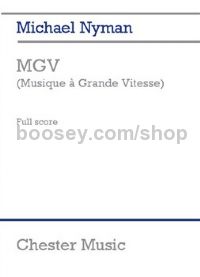MGV (Musique à Grande Vitesse) (study score)
MGV (Musique à Grande Vitesse) (study score)
* Estimated price converted from UK retail price
Musique à Grande Vitesse (MGV) translates as ‘high speed music’ and was commissioned by the Festival de Lille for the inauguration of the TGV North European Paris-Lille line in 1993.
The piece runs continuously, but was conceived as an abstract, imaginary journey; or rather five inter-connected journeys, each ending with a slow, mainly stepwise melody which is only heard in its 'genuine' form when the piece reaches its destination.
Thematic 'transformation' is a key to MGV as a whole. Throughout the piece ideas - rhythmic, melodic, harmonic, motivic, textural - constantly change their identity as they pass through different musical 'environments'.
The opening bars establish both a recurrent rhythmic principle - 9, 11, or 13-beat rhythmic cycles heard against a regular 8 - and a harmonic process - chord sequences (mainly over C and E) which have the note E in common. (Coincidentally, MGV begins in C and ends in E). A later scalic, syncopated figure (again first heard over C, E and A) begins the second section, featuring Brass, in D flat.
The topography of MGV should be experienced without reference to planning, description or timetables. The piece’s tempo changes and unpredictable slowings down bear no logical relation to the high speed of the Paris-Lille journey, while the temptation to treat MGV as a concerto grosso, with the Michael Nyman band as the ripieno, was resisted: more suitably the band (amplified in live performance) lays down the tracks on which MGV runs.




